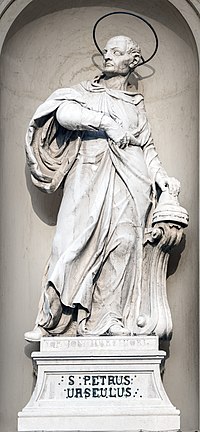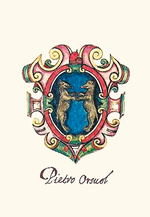Pietro I Orseolo
St. Pietro Orseolo, O.S.B. Cam. | |
|---|---|
 | |
| Doge | |
| Born | 928 Udine, Republic of Venice |
| Died | 10 January 987 Cuxa, County of Conflent |
| Venerated in | Catholic Church (Patriarchate of Venice & Camaldolese Order) |
| Beatified | 1027 by Arnulf |
| Canonized | 1731, Rome, Papal States, by Pope Clement XII |
| Major shrine | Prades, Pyrénées-Orientales, France |
| Feast | 10 January; 14 January (Pre 1969), 19 January (Camaldolese) |
Pietro I Orseolo, O.S.B. Cam. (Peter Urseulus) (928–987) was the Doge of Venice from 976 until 978. He abdicated his office and left in the middle of the night to become a monk. He later entered the Camaldolese Order. He is venerated as a saint in the Catholic Church following his canonization in 1731. In 1733 the Venetian librarian Giuseppe Bettinelli published an edition of a biography written by the heretical Friar Fulgenzio Manfredi in 1606.[1]
Early life[]
Orseolo was born in 928 near Udine to one of the more powerful families in Venice: the Orseolo who were the descendants of Teodato Ipato and Orso Ipato. At the age of 20 he was named commander of the Venetian fleet, performing distinguished service as a soldier; he waged successful campaigns against the Dalmatian pirates. He was also devoted to the Catholic Church.
Reign[]

In 976, the sitting doge, Pietro IV Candiano, was killed in a revolution that protested his attempts to create a monarchy. According to a statement by the Camaldolese monk and cardinal, Peter Damian, Orseolo himself had led a conspiracy against Candiano. This statement, however, cannot be verified. Nonetheless, Orseolo was elected as his successor. His wife and consort was Felicia Malipiero.[2]
As doge, Orseolo demonstrated a good deal of talent in restoring order to an unsettled Venice and showed remarkable generosity in the treatment of his predecessor's widow. He built hospitals and cared for widows, orphans and pilgrims. Out of his own resources he began the reconstruction of the ducal chapel, now St. Mark's Basilica, and the doge's palace, which had been destroyed during the revolution, along with a great part of the city. Two years later, on 1 September 978, seemingly without notifying anyone, not even his wife and children, he left Venice with Abbot Guarin and three other Venetians (one of whom was St. Romuald) to join the Benedictine (now Cistercian) abbey at Saint-Michel-de-Cuxa (Catalan: Sant Miquel de Cuixà) in Prades (Catalan: Prada), southern France.
Here Orseolo led a life of great asceticism, performing the most menial tasks. There is some evidence that he had been considering such an action for some time. His only contact with Venice was to instruct his grandson Otto[3] (who would become doge in 1008) in the life of Christian virtue. After some years as a monk at the abbey, probably with the encouragement of Saint Romuald (who later went on to found the Camaldolese branch of the Benedictines), Orseolo left the monastery to become a hermit in the surrounding forest, a calling he followed for seven years until he died. His body is buried in the village church in Prades (Catalan: Prada), France.
Veneration[]
Forty years after his death, in 1027, Orseolo was officially recognized as a blessed by the local bishop.
Orseolo is venerated as a saint by the Catholic Church, his cultus having been confirmed by his equivalent canonization in 1731 by Pope Clement XII, who set his feast day for January 14. The reform of the liturgical calendar in 1969 transferred the feast to January 10, the day of his death. The Camaldolese, however, celebrate his memory on January 19.[4]
See also[]
- Saint Pietro I Orseolo, patron saint archive
References[]
- ^ Guido Grandi (1733). Vita del glorioso prencipe S. Pietro Orseolo doge di Venezia, indi monaco, ed eremita santissimo, primo discepolo di S. Romualdo fondatore dell'Ordine camaldolese; scritta da un religioso di detto Ordine . (in Italian). unknown library. per Giuseppe Bettinelli in Merceria.
- ^ Staley, Edgcumbe (1910). The dogaressas of Venice : The wives of the doges. University of California Libraries. London : T. W. Laurie.
- ^ Turton, W.H. (1928). The Plantagenet Ancestry. London: Phillimore.
- ^ "San Pietro Orseolo (Urseolo)". Santi e Beati (in Italian).
External links[]
| Wikimedia Commons has media related to Pietro I Orseolo. |
- Peter Urseolus at the Catholic Encyclopedia
- Attwater, Donald and Catherine Rachel John. The Penguin Dictionary of Saints. 3rd edition. New York: Penguin Books, 1993. ISBN 0-14-051312-4.
- 928 births
- 987 deaths
- House of Orseolo
- People from Udine
- 10th-century Doges of Venice
- Camaldolese saints
- Italian Benedictines
- Italian hermits
- Medieval Italian saints
- 10th-century Christian saints